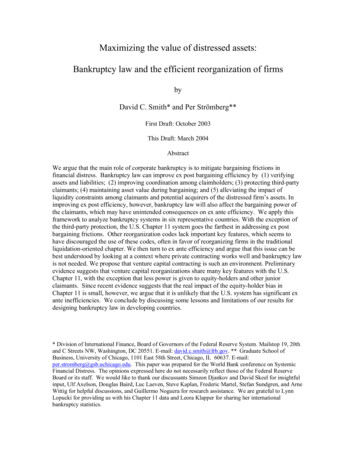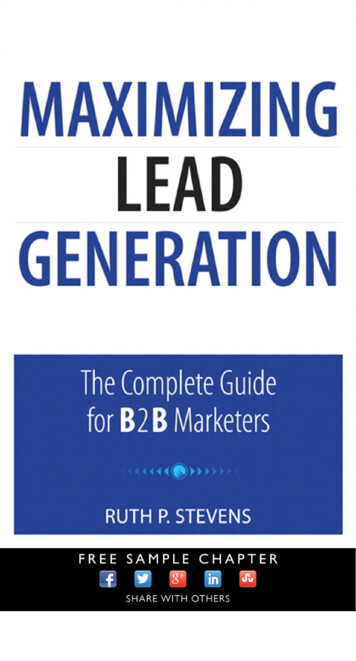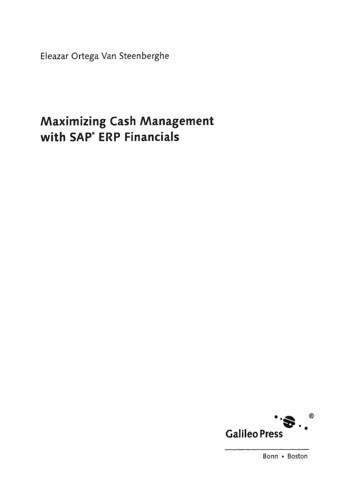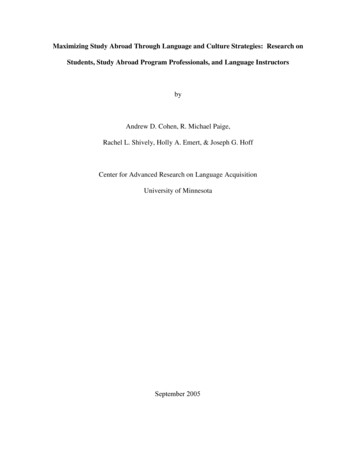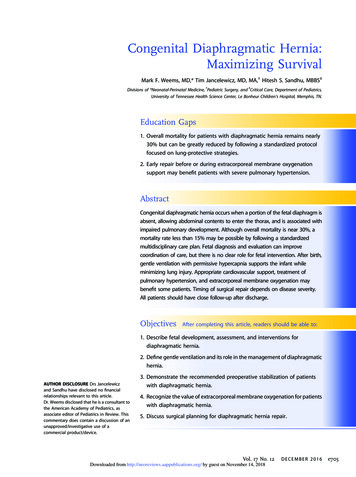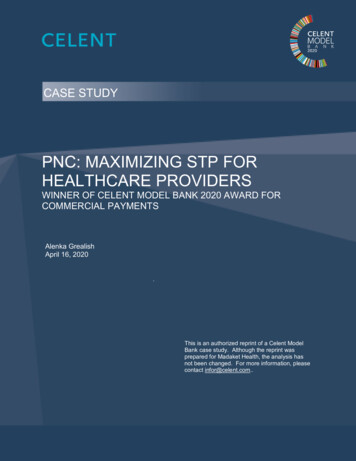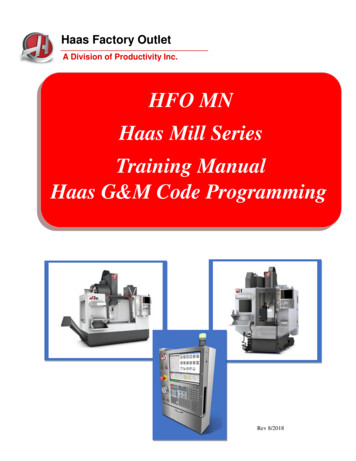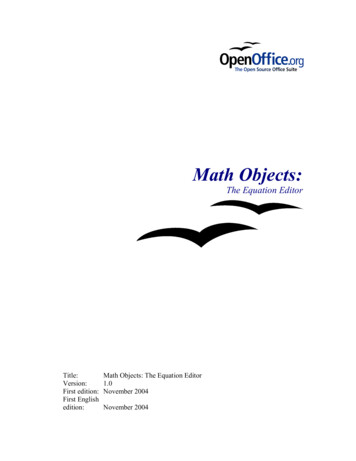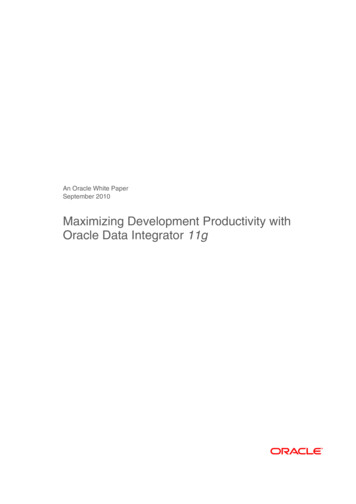
Transcription
An Oracle White PaperSeptember 2010Maximizing Development Productivity withOracle Data Integrator 11g
Oracle White Paper— Maximizing Development Productivity with Oracle Data Integrator 11gDisclaimerThis document is for informational purposes. It is not a commitment to deliver any material,code, or functionality, and should not be relied upon in making purchasing decisions. Thedevelopment, release, and timing of any features or functionality described in this documentremains at the sole discretion of Oracle.This document in any form, software or printed matter, contains proprietary informationthat is the exclusive property of Oracle. This document and information contained hereinmay not be disclosed, copied, reproduced, or distributed to anyone outside Oracle withoutprior written consent of Oracle. This document is not part of your license agreement nor canit be incorporated into any contractual agreement with Oracle or its subsidiaries or affiliates.1
Oracle White Paper— Maximizing Development Productivity with Oracle Data Integrator 11gExecutive OverviewOracle Data Integrator (ODI) is a best-of-breed data integration platform focused on fast bulkdata movement and handling complex data transformations. The 11g version of ODI advancesthis state of the art technology even further ahead of the rest of the industry.One of the key product objectives with Oracle Data Integrator 11g is to maximize ETLdeveloper productivity and efficiency by providing new features that help quickly deliver highquality integration processes and meet project requirements ahead of schedule and under projectbudget.This whitepaper describes in detail these new productivity features and capabilities offered in theODI 11g data integration platform.2
Oracle White Paper— Maximizing Development Productivity with Oracle Data Integrator 11gDefining ProductivityDevelopment Productivity can be defined as “the rate at which one can develop quality deliverables thatmeet the requirements”.While meeting the project requirements may not be at the heart of every productivity discussion,it is the single most important driver for any project, regardless of the particular developmentmethodology in place. Meeting these projects requirements on time is a totally different story, anddeveloper productivity is the main factor in meeting this challenge of time.Productivity discussions for ETL projects can include a variety of concerns, includingcode/mapping creation, maintenance efficiency, detecting issues and avoiding errors.Oracle Data Integrator 11g introduces new capabilities to support productivity, including:An Enterprise Scale Infrastructure for DevelopmentAn Efficient Design-Time ExperienceBetter Error Control & ManagementA Java API for Task AutomationAn Enhanced Declarative Design ApproachEnterprise Scale Infrastructure for DevelopmentA reliable, efficient and secure infrastructure supporting a powerful solution is critical for anydevelopment effort. In short, no one wants developers to spend their time “waiting for thesystem to respond or to be back online”. An unreliable, unavailable or insecure developmentinfrastructure is a waste of time, money and productivity.Oracle Data Integrator 11g provides several new features for an Enterprise-Scale Architecture. Thesefeatures guarantee that:Any component of Oracle Data Integrator can be always availableAny unexpected failures in the infrastructure can be quickly identified and resolvedThe infrastructure is integrated with popular enterprise security systems.Features for an Enterprise-Scale Architecture include:High-Availability (HA) and Scalability supported via clustered deployments for Java EE andStandalone components. Java EE components deployed in WebLogic Server benefit from thecapabilities of the WLS cluster and Coherence data grid for scalability, including JDBCConnection Pooling and Load Balancing. Standalone agents support the ODI built-in load-3
Oracle White Paper— Maximizing Development Productivity with Oracle Data Integrator 11gbalancing feature and can be protected using Oracle Process Manager and Notification Server(OPMN).Figure 1- High Availability Configuration for Oracle Data Integrator JEE ComponentsConnection Retry mechanism to transparently recover sessions with repositories stored inhighly available database engines such as Oracle RAC.Stale Sessions Management: Sessions stopped due to a repository or the run-time agent failureare automatically identified as stale and moved from the Running state to the Error state forreview.Unified management via a plug-in that integrates in Enterprise Manager Fusion MiddlewareControl to monitor the status, metrics, and notifications of Oracle Data Integratorcomponents, including Repositories and Agents.New Oracle Data Integrator Console that replaces and unifies the former 10g MetadataNavigator and Lightweight Designer components. This web interface for monitoring andmetadata browsing has been rewritten using the Oracle ADF-Faces Ajax Framework for a richuser experience.Support for external password storage to safeguard data servers and context passwords into acorporate credential store.4
Oracle White Paper— Maximizing Development Productivity with Oracle Data Integrator 11gSupport for external authentication to have ODI users authenticate against an externalenterprise identity store (LDAP, Oracle Internet Directory, Active Directory), using theirSingle Sign-On (SSO).Efficient Design-Time ExperienceOracle Data Integrator 11g introduces a new JDeveloper-based Integrated DevelopmentEnvironment (IDE) called the Oracle Data Integrator Studio. This client is redesigned in thisrelease to dramatically increase the developer’s productivity and simplify access to advancedfeatures.New IDE Based on JDeveloperThe new Oracle Data Integrator Studio, based on Oracle JDeveloper replaces all Oracle DataIntegrator 10g graphical modules (Designer, Topology, Operator, and Security Manager).The new IDE provide state-of-the-art features for developer efficiency, including redesigned andreorganized editors in addition to enhanced windows, improved docking, and documentnavigation and management.Single IDE with Multiple NavigatorsThe features of the ODI modules now appear as Navigators within the Oracle Data IntegratorStudio window. This new organization provides the following features:Navigators can be docked/undocked and displayed/hidden using the View menu. TheseNavigators allow access to the former module-specific actions from their Navigator toolbarmenu (for example, the export/import master repository operations in the TopologyNavigator)Accordions group the tree views that appear in the Navigators (for example the Project andModels accordions in the Designer Navigator). Accordions that are not frequently used can beminimized into the lower section of the Navigator to allow more room for the other treeviews. Accordions allow access to the tree view-specific actions from their toolbar menu (forexample, import project from the Project Accordion in the Designer Navigator).Tree Views objects are provided with context menus and markers, they can be dragged anddropped within a tree view or across tree views for defining the security policies. Doubleclicking an object opens by default the corresponding Object Editor.Context Menus have been reorganized into groups with separators and normalized across theinterface.5
Oracle White Paper— Maximizing Development Productivity with Oracle Data Integrator 11gWindow ManagementThe windows, editors and navigators in the Oracle Data Integrator Studio benefit from theJDeveloper IDE features, including:Full Docking Support: All windows, editors and navigators can now be docked, undocked,stacked and organized intuitively. Stacked items appear with a tab as their title.Fast maximize and restore: Quickly maximize or restore a dockable window or editor bydouble-clicking on the title bar.Figure 2 – In Oracle Data Integrator Studio, Editing an Interface (visible editor), a model, a package and a physical agent.Document Management and NavigationObject edition has been enhanced with the Oracle Data Integrator Studio. This includes:Save and close multiple editors: You can easily save all your work with a single click using theFile Save All option and close all opened editors similarly. You can also close all the editorsbut the current one.Forward and back buttons: Now you can easily return to a previously visited document withthe convenient browser-style forward and back buttons on the main toolbar. These buttons6
Oracle White Paper— Maximizing Development Productivity with Oracle Data Integrator 11gmaintain a history, so you can drop down the back or forward button to get a list of thedocuments and edit locations you have visited. Alt Left and Alt Right activate the back andforward buttons.Quick document switching: Switching between editors and navigators is also possible. Nowwhen you press Ctrl Tab or Ctrl F6, you can choose which document you want to switchfrom a list ordered by the most recently used. You can use the same technique to switchbetween open dockable windows by first placing focus in a dockable window, then pressingCtrl Tab or Ctrl F6.Redesigned EditorsAll object editors in Oracle Data Integrator have been redesigned for better usability.Main changes include:Tabs are organized as finger tabs on the left hand-side of the editor. Complex editors (as forexample Interface or Package Editors) have also tabs appearing in the bottom of the editor.Fields have been grouped under headers. These field groups implement an expand/collapsebehavior.Fields and labels have been organized in a standard way for all editors for a better readability ofthe editors.Text Buttons in the editors are transformed into hyperlinks, and all buttons appearing ineditors have been redesigned.Knowledge Modules, Actions and Procedure editors have been redesigned in order to edit theLines directly from the main editor instead of opening a separate editor.Figure 3 - Redesigned Editor Example: Procedure Editor.7
Oracle White Paper— Maximizing Development Productivity with Oracle Data Integrator 11gRedesigned Interface EditorThe editor used to create the integration interfaces has been entirely redesigned to use theJDeveloper diagramming framework.Figure 4- Interface Editor (Mapping) with Thumbnail view and compacted lookup object.This new diagram provides the following benefits:Improved look and feel and better user experienceSupport for graphical options on diagram objects. For example, compact and expanded viewcan be used for better readability.Thumbnail and zoom in/out is supported on the sources and flow diagram to navigate largediagrams.Multiple source columns can be dropped directly onto a target column for faster mapping.8
Oracle White Paper— Maximizing Development Productivity with Oracle Data Integrator 11gTarget mapping table is improved. Mapping properties (Position, Indicator, Name andMapping expression) can be displayed selectively and sorted.Sources, targets, filters, joins can be selected and edited directly in the flow diagram.Source column drag and drop in the target mappingReorganized and searchable Property Inspector for interface components (joins, lookups, etc)Figure 5- Interface Editor (Flow), with expanded source datastore and thumbnail view.Quick-EditThe new interface editor includes a new Quick-Edit tab to edit the interface diagram faster. TheQuick-Edit tab displays the interface components in a tabular form, and allows faster creation ofedition of an interface.9
Oracle White Paper— Maximizing Development Productivity with Oracle Data Integrator 11gFigure 6 –Interface Editor - Quick Edit ViewQuick Edit supportsIntuitive and Accessible Keyboard NavigationMultiple cell updates and Copy-paste operationsColumn displayed selectively and can be sortedQuick Edit facilitates interface development, review and maintenance by providing a simple andcompact view of the interface content.Other Usability FeaturesIn addition to these major changes, other improvements have been made in the ODI Studio tomake the developer’s life easier. For example:10
Oracle White Paper— Maximizing Development Productivity with Oracle Data Integrator 11gReverse-Engineering -When a model is created, the reverse-engineering context isautomatically set to the default context. In addition, when performing a selective reverseengineering, the system tables are now hidden from the display.Scenario Naming Convention – A user can define a pattern (using for example the objectname, folder path, or project name) for the naming convention that is automatically applied tonew scenarios created by this user.Long Object Names - Object names have been extended to support long database objectnames (128 characters) and repository object labels (400 characters).Purge Log on Session Count - The OdiPurgeLog tool has been enhanced to support apurge of the log while retaining only a number of sessions in the log. Purged sessions can beautomatically archived by the tool before performing the purge.Import Report - After objects have been imported, an import report displays the objects thathave been imported or deleted in the target repository. Missing objects referenced by theimported objects are indicated as missing references. Such missing references can be fixed by asubsequent import. Import reports can be saved in XML or HTML format. With this feature,import becomes a fully traceable operation as all changes can be identified and archived.Figure 7 - Import Report indicates any object altered by an import operation.11
Oracle White Paper— Maximizing Development Productivity with Oracle Data Integrator 11gBetter Error Control & ManagementDevelopment is not about “dumping code” as fast as possible, and development in Oracle DataIntegrator is not simply about creating interfaces and packages and hope that they will work.High quality development with ODI is about prod
Oracle Data Integrator 11g. Oracle White Paper— Maximizing Development Productivity with Oracle Data Integrator 11g 1 Disclaimer This document is for informational purposes. It is not a commitment to deliver any material, code, or functionality, and should not be relied upon in making purchasing decisions. The development, release, and timing of any features or functionality described in .
